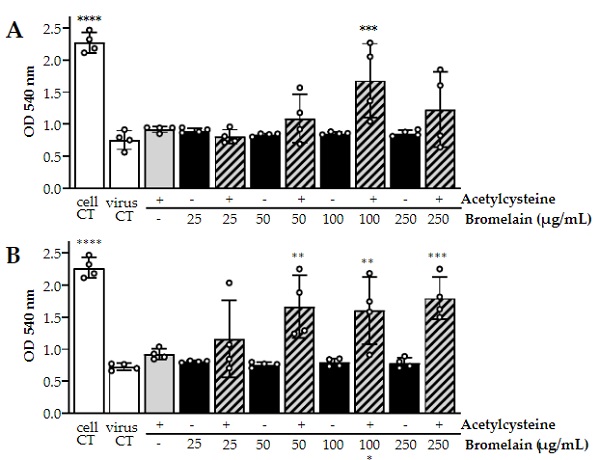Acetylcysteine and Bromelain may HALT CLOTTING and UNFOLD spike proteins
I’m not sure who first started publicizing this study, but I found it widely posted on Brighteon.social.
The study is titled, “The Combination of Bromelain and Acetylcysteine (BromAc) Synergistically Inactivates SARS-CoV-2.”
It was published in the journal Viruses and appears on Researchgate.net as well as other science article indexing hubs. The full text of the article is available to the public for free.
Authored by a group of researchers — with Ahmed Mekkawy the lead researcher — the study looked at how bromelain and acetylcysteine — also known as the supplement form NAC — alters the glycoproteins of the spike protein. The following chart shows changes in the opacity of SARS-CoC-2 cell cultures upon exposure to different concentrations of the BromAc nutrition combination: (note that the micrograms per mL means ppm, so these are fairly low concentrations yet still have a measurable impact):

Figure 2.Cell lysis assays demonstratedin vitroinactivation potential of Acetylcysteine and Brome-lain combined (BromAc) against SARS-CoV-2. Cell viability was measured by cell staining withNeutral Red, where optical density (OD) is directly proportional to viable cells. Low OD wouldsignify important cell lysis due to virus replication.
The conclusion of the study explains how this combination of Bromelain and Acetylcysteine alters the structure of the SARS-CoC-2 glycoproteins, rendering them unable to attack human cells: (emphasis added)
The combination of Bromelain and Acetylcysteine, BromAc, synergistically inhibited the infectivity of two SARS-CoV-2 strains cultured on Vero cells. Protein con?rmation and its molecular properties are dependent on its structural and geometric integrity, which are dependent on both the peptide linkages and disul?de bridges. Acetylcysteine, as a good reducing agent, tends to reduce the disul?de bridges and hence alter the molecular properties of most proteins. This property has been widely exploited in the development of several therapies (chronic obstructive pulmonary disease, allergic airways diseases,cystic ?brosis, pseudomyxoma peritonei, etc.) [20,23–27]. More recently, Acetylcysteine has been used in the development of therapies for respiratory infections such as in?uenza and COVID-19 [28–30], where the integrity of the spike protein is vital for infection [12,13]. A hypothesized mechanism of action could be the unfolding of the spike glycoprotein and the reduction of its disul?de bonds.
A direct mechanical action against this spike protein is a different treatment strategy in comparison to most of the existing antiviral drugs, which prevents viral entry in host cells rather than targeting the replication machinery. BromAc acts as a biochemical agent to destroy complex glycoproteins. Bromelain’s multipotent enzymatic competencies, dominated by the ability to disrupt glycosidic link-ages, usefully complement Acetylcysteine’s strong power to reduce disul?de bond.
The potential of BromAc on SARS-CoV-2 spike and envelope proteins stabilized by disul?de bonds was examined and found to induce the unfolding of recombinant spike and envelope proteins by reducing disul?de stabilizer bridges. BromAc also showed an inhibitory effect on wild-type and spike mutant SARS-CoV-2 by inactivation of its replication capacity in vitro. Hence, BromAc may be an effective therapeutic agent for early SARS-CoV-2infection, despite mutations, and even have potential as a prophylactic in people at high risk of infection.
Importantly, it should be noted that these tests were carried out in vitro, and there have not been any human clinical trials on this combination that I’m aware of, since the NIH would never fund anything other than Big Pharma drugs and vaccine research. Consider the information presented here as a theoretical route action that warrants further exploration.
Nevertheless, given that bromelain and acetylcysteine are widely consumed as nutritional supplements right now — and are readily available and affordable — these solutions warrant consideration as low-cost, low-risk interventions that may prove to help save lives.










Comments